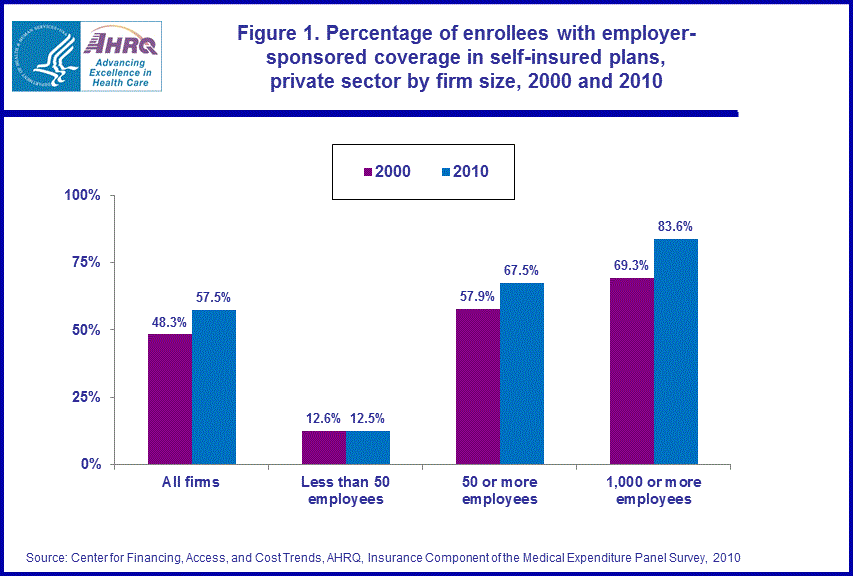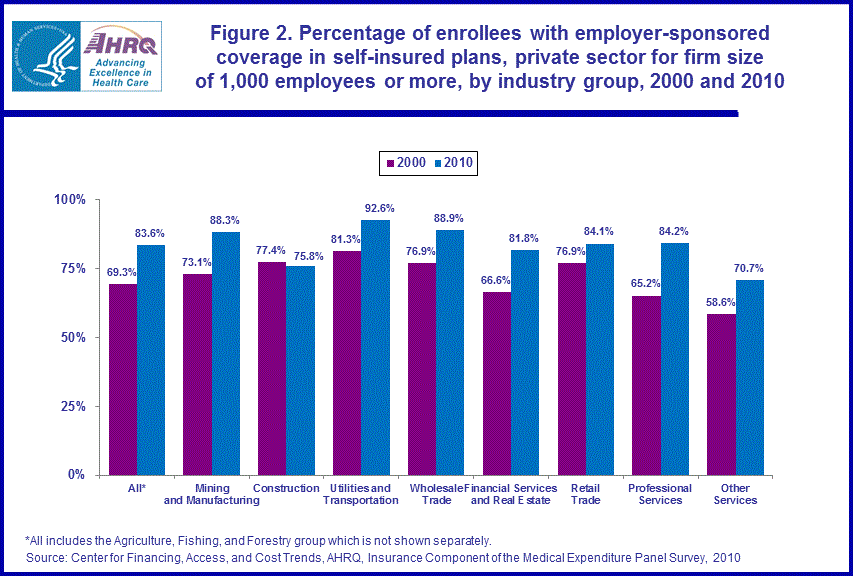
|
|
Font Size:
|
||||
|
|
|
|
||||
STATISTICAL BRIEF #339:
Self-Insured Coverage in Employer-Sponsored Health Insurance for the Private Sector, 2000 and 2010
Highlights
- Self-insurance was more common among large employers in the private sector in 2010, with 67.5 percent of enrollees in large firms (50 or more employees) in self-insured plans versus 57.5 percent of all enrollees.
- In firms with 1,000 or more employees, total enrollment in self-insured plans rose from 69.3 percent in 2000 to 83.6 percent in 2010. The percentage of self-insured enrollees increased significantly for most industry groups over the period in these very large firms.
Introduction
Employers that offer health insurance to their employees can provide that coverage either through self-insured plans or through fully-insured plans purchased from an insurance company. When an employer chooses to self-insure coverage, it generally takes on the financial risk associated with paying the plan’s costs although employers with such plans commonly purchase stop-loss coverage to limit their financial exposure. Employers that sponsor fully-insured plans generally pay premiums to an insurer and the insurer bears the financial risk.Self-insured and fully-insured coverage are not treated the same way under the law. State laws that regulate fully-insured employer-sponsored plans usually do not apply to self-insured plans. And some provisions of the federal Patient Protection and Affordable Care Act of 2010 pertain to fully-insured plans but not to self-insured plans.
Larger firms often offer a choice of health plans with different benefits and costs to their employees—the options may include both self-insured and fully-insured plans. For example, a self-insured Preferred Provider Organization (PPO) may be offered at all sites nationwide while different fully-insured Health Maintenance Organizations (HMOs) are offered at various work locations in different states.
This Statistical Brief is limited to an analysis of enrollment in self-insured health insurance plans. Of the total 56.1 million employees with employer-sponsored coverage in the private sector in 2010, 32.3 million were enrolled in plans that were self-insured by their employers. The Brief discusses self-insurance enrollment rates for small versus large employers and across industry groups in 2010, and changes since 2000, for private sector firms.
This analysis is based on estimates from the Insurance Component of the Medical Expenditure Panel Survey (MEPS-IC). Only comparisons with a statistically significant difference at the 0.05 percent significance level are noted in the text.
Findings
2010 statisticsSelf-insurance occurs more often among large employers, since their health costs for a larger number of enrollees are more predictable and therefore less financially risky than for those small employers with a smaller number of enrollees. Overall, in 2010 in the private sector, 57.5 percent of enrollees had health coverage that their employers self-insured (figure 1). But 67.5 percent of enrollees working in large firms (those with 50 or more employees) were in self-insured plans. Very large firms with 1000 or more employees had an even greater percentage of enrollees in self-insured plans, 83.6 percent. These percentages contrast with only 12.5 percent of enrollees being in self-insured plans in small firms (those with fewer than 50 employees).
Examining firms of 1,000 or more employees by industry group, the percentage of enrollees covered by self-insured plans ranged from a low of 70.7 percent for Other Services to a high of 92.6 percent for Utilities and Transportation in 2010 (figure 2). Both of these percentages were significantly different than the U.S. average of 83.6 percent for these very large firms. The percentage of self-insured plan enrollees was also above average for the Mining and Manufacturing group (88.3 percent) in these firms. Other industry groups had percentages that were not significantly different than the U.S. average in 2010.
Changes from 2000 to 2010
From 2000 to 2010, the overall percent of enrollees with employer-sponsored health insurance that had self-insured coverage rose from 48.3 percent to 57.5 percent (figure 1). In small firms, the percentage was unchanged over the period at 12.5 percent in 2010. For large firms of 50 or more employees, the percent of self-insured enrollees rose from 57.9 percent to 67.5 percent over the period.
In firms with 1,000 or more employees, the enrollment in self-insured plans increased from 69.3 percent in 2000 to 83.6 percent in 2010 (figure 2). For these very large firms, by industry, all groups except Construction and Retail Trade had significant increases in the percentage of enrollees in employer-sponsored, self-insured plans over the period.
Data Source
This Statistical Brief summarizes data from the 2000 and 2010 MEPS-IC. The data are available on the MEPS Web site at http://www.meps.ahrq.gov/mepsweb/survey_comp/Insurance.jsp or have been produced using special computation runs on the confidential MEPS-IC data available at the U.S. Census Bureau.Definitions
EmployeeA person on the actual payroll. Excludes temporary and contract workers but includes the owner or manager if that person works at the firm.
Firm
A business entity consisting of one or more business establishments under common ownership or control. A firm represents the entire organization, including the company headquarters and all divisions, subsidiaries, and branches. A firm may consist of a single-location establishment, in which case the establishment and firm are identical.
Health insurance plan
An insurance contract that provides hospital and/or physician coverage to an employee for an agreed-upon fee (premium) for a defined benefit period.
Industry group
The classification by industry is based upon the North American Industrial Classification System, available at http://www.census.gov/eos/www/naics/. Estimates for the Agriculture, Fishing, and Forestry sector have been excluded from this analysis.
Self-insured plan
A plan offered by employers where the financial risk for the enrollee's medical claims is assumed partially or entirely by the employer offering the plan. Employers with self-insured plans commonly purchase stop-loss coverage from a reinsurer who agrees to bear the risk (or stop the loss) for those expenses exceeding a predetermined dollar amount. Some self-insured employers contract with an insurance company or third party administrator for claims processing and other administrative services.
About MEPS-IC
The MEPS-IC is a survey of business establishments and governments that collects information on employer-sponsored health insurance, such as whether insurance is offered, enrollments, types of plans, and premiums. The survey is conducted annually by the U.S. Census Bureau under the sponsorship of the Agency for Healthcare Research and Quality (AHRQ). A total sample of approximately 42,000 private-sector establishments was selected for the 2010 survey, with 8.3 percent of the sample determined to be out-of-scope during the data collection process. The response rate for the private-sector was 82.7 percent of the remaining in-scope sample units.For more information on this survey, see MEPS Methodology Reports 6, 8, 10, 14, 17, and 18 on the MEPS Web site at http://www.meps.ahrq.gov/mepsweb/data_stats/Pub_ProdLookup_Results.jsp?ProductType=Methodology%20Report&Comp=Insurance and Insurance Component Survey Basics at http://www.meps.ahrq.gov/mepsweb/survey_comp/Insurance.jsp.
Suggested Citation
Crimmel, B. L. Self-Insured Coverage in Employer-Sponsored Health Insurance for the Private Sector, 2000 and 2010. Statistical Brief #339. September 2011. Agency for Healthcare Research and Quality, Rockville, MD. http://www.meps.ahrq.gov/mepsweb/data_files/publications/st339/stat339.shtmlAHRQ welcomes questions and comments from readers of this publication who are interested in obtaining more information about access, cost, use, financing, and quality of health care in the United States. We also invite you to tell us how you are using this Statistical Brief and other MEPS data and tools and to share suggestions on how MEPS products might be enhanced to further meet your needs. Please e-mail us at MEPSProjectDirector@ahrq.hhs.gov or send a letter to the address below:
Steven B. Cohen, PhD, Director
Center for Financing, Access, and Cost Trends Agency for Healthcare Research and Quality 540 Gaither Road Rockville, MD 20850
 |
||||||||||||||||||||||||||||||||||||
|
||||||||||||||||||||||||||||||||||||
|
|
||||||||||||||||||||||||||||||||||||
 |
||||||||||||||||||||||||||||||||||||
|
||||||||||||||||||||||||||||||||||||
|
|
||||||||||||||||||||||||||||||||||||


